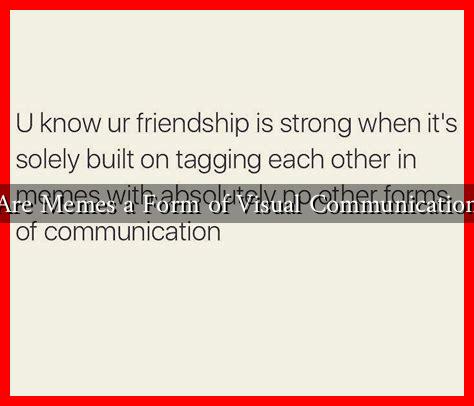-
Table of Contents
Are Memes a Form of Visual Communication?
In the digital age, memes have emerged as a dominant form of expression, transcending cultural and linguistic barriers. But what exactly are memes, and can they be classified as a form of visual communication? This article delves into the nature of memes, their role in communication, and their impact on society.
Understanding Memes
Memes are typically humorous images, videos, or text that are shared widely across social media platforms. They often rely on cultural references, satire, and irony to convey messages. The term “meme” was coined by British evolutionary biologist Richard Dawkins in his 1976 book, “The Selfish Gene,” where he described it as an idea that spreads from person to person within a culture.
The Mechanics of Visual Communication
Visual communication involves conveying ideas and information through visual aids. This can include images, symbols, graphs, and videos. Memes fit into this category as they use visuals to communicate complex ideas quickly and effectively. Here are some characteristics that make memes a unique form of visual communication:
- Conciseness: Memes often convey messages in a single image or a few words, making them easily digestible.
- Relatability: They often tap into shared experiences or cultural references, making them relatable to a wide audience.
- Humor: Many memes use humor to engage viewers, making the message more memorable.
- Virality: The shareable nature of memes allows them to spread rapidly, amplifying their reach and impact.
Case Studies: Memes in Action
To understand the power of memes as a form of visual communication, let’s look at a few notable examples:
The Distracted Boyfriend Meme
This meme features a man looking at another woman while his girlfriend looks on disapprovingly. It has been used to represent various scenarios, from personal relationships to political commentary. The simplicity of the image allows for a wide range of interpretations, making it a versatile tool for communication.
The “This Is Fine” Meme
Originating from a webcomic, this meme depicts a dog sitting calmly in a burning room, saying, “This is fine.” It has become a symbol of denial in the face of disaster, often used to comment on social and political issues. Its visual simplicity and relatable context make it a powerful form of communication.
Statistics and Impact
The impact of memes on communication is significant. According to a study by the Pew Research Center, 55% of U.S. adults aged 18-29 reported that they often encounter memes on social media. Furthermore, memes have been shown to influence public opinion, especially during elections. A study published in the journal “Political Communication” found that memes can shape political discourse and voter behavior.
The Future of Memes as Visual Communication
As technology evolves, so does the nature of memes. With the rise of augmented reality (AR) and virtual reality (VR), the potential for memes to become even more immersive and interactive is on the horizon. This evolution could further enhance their role as a form of visual communication.
Conclusion
In conclusion, memes are indeed a form of visual communication that encapsulates complex ideas in a simple, relatable format. Their ability to convey messages quickly and humorously makes them a powerful tool in the digital landscape. As we continue to navigate an increasingly visual world, understanding the role of memes in communication will be essential for both individuals and organizations. Whether used for humor, social commentary, or political discourse, memes have solidified their place as a significant medium of expression in contemporary society.
For further reading on the impact of memes in communication, you can explore resources like Pew Research Center and JSTOR.


